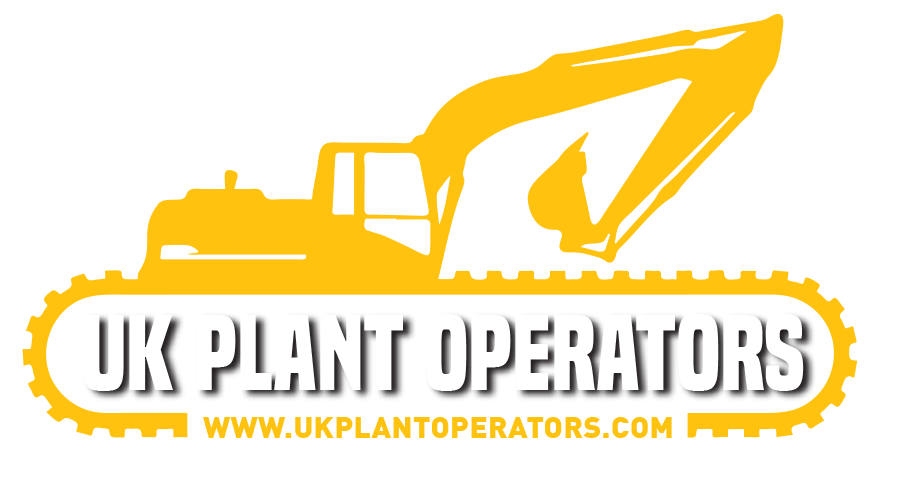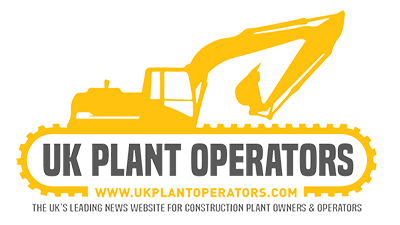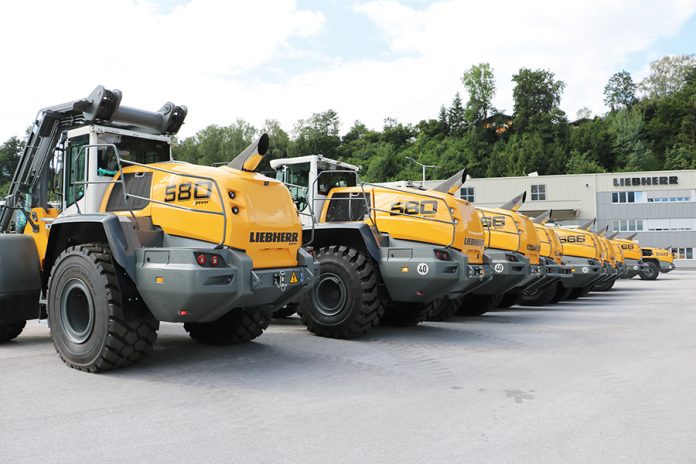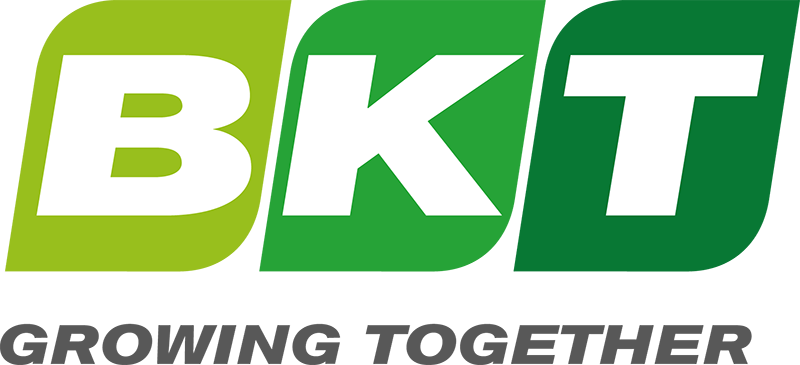![]()
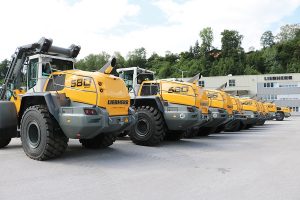
Liebherr build many things. Cranes, diggers, dozers and even fridges. They are also handy at building loading shovels. In a factory near Salzburg, in Austria, their loading shovels are created. To see how they do it was Darren Scully.
“The hills are alive with the sound of music” belted out the very talented Julie Andrews. You will remember her and the Von Trapp family running up and down the side of a mountain, singing to their heart content. The film, the sound of music, was a smash hit and was made in Salzburg. Every Christmas, everyone in the world gets to sit on the couch and watch it. Everyone in the world except if you are Austrian.
You see, whilst visiting the Liebherr loading shovel factory in Bischofshofen, which is about a half an hour drive to Salzburg, it was quickly brought to my attention that the Austrians don’t watch it, in fact they hate it. In these parts they prefer to remind people that this is where the best music in the world was created by a famous Salzburg son, Wolfgang Amadeus Mozart. They also like to remind you that this is where they build the worlds finest loading shovels. Yes, indeed, this was why I was here. A tour of the Liebherr loading shovel factory, to see first-hand how they build their machines and to talk to the people who build them.
History
In 1960, Liebherr founded the company group’s first Austrian plant in Bischofshofen. Today, Liebherr-Werk Bischofshofen GmbH employees around 1,100 employees on grounds covering approximately 170,000 m². The site is specialised in the development, production and international marketing and sales of Liebherr wheel loaders. The company here is also responsible for the marketing and service of all Liebherr construction machinery in Austria.
The plant located in the federal state of Salzburg has continually grown over the decades, thanks to enduring innovation, creative solutions and high-quality standards. These strengths, coupled with an extensive product range, allow Liebherr to play a pioneering role in shaping a successful future at the Bischofshofen site. Liebherr-Werk Bischofshofen GmbH started with manufacturing fast-erecting cranes and crawler cranes. Since 1985, the factory has been tasked with production of the entire wheel loader range. The plant then specialised in the development, production and marketing of wheel loaders in 1997. Since then, the wheel loader experts based here have continually been setting new milestones when it comes to technology and design.
What they build
Everything about the trip and tour was run to a high standard. Pick up times, transfers from hotel to the factory, lunch, dinner, answers to questions, all done in the usual high quality Liebherr way. On arrival to the factory, the first thing that grabbed my attention, was the awe-inspiring view. The mountains all around us, beautiful rolling countryside, the smell of crisp fresh air.
In the distance I could see the ski-jump that during the winter months is used for the European Ski championships. As work settings go, it did not get better than this. The yard was full of new loading shovels of various sizes. The factory currently offers wheel loaders in four different categories: Compact loaders, Stereoloaders, mid-size wheel loaders and large wheel loaders of the XPower generation.
The XPower concept was developed at this factory for their large wheel loaders L550 XPower to L586 XPower. The heart of the XPower wheel loader is its power-split driveline, which Liebherr installs as standard in these machines. This combines the hydrostatic drive, perfect for short loading cycles, with the mechanical drive, whose advantages are clearly apparent over long distances and during ascents. The combination of both drive types in one-wheel loader ensures maximum efficiency and good fuel savings.
The current series of mid-size wheel loaders comprises three machines: the L526, L538 and L546 models. The high-quality steel construction and robust axles ensure the utmost reliability for these wheel loaders. The modern cab is tailored to the machine operator’s needs. Its logical design not only feels ample and spacious, it also provides good all-round visibility thanks to large window areas. The manoeuvrability of the four Stereoloaders L507, L509, L514 and L518 is truly impressive. This is due to stereo steering, a perfectly balanced combination of articulated steering and rear axle steering.
The unique steering system combines the advantages of conventional articulated steering with those of all-wheel steering. The result is a minimal turning circle which is very practical in cramped conditions. The compact loaders L 506 and L 508 represent powerful yet reliable machinery for diverse applications involving road building, civil engineering, horticulture and landscaping.
With bucket sizes from 0.8 to 1.0 m³, these complement the range of small Liebherr wheel loaders. I also spotted other brands of loaders such as CLAAS and John Deere which are built here by Liebherr.
The Tour
After a chat with the Liebherr shovel salespeople it was time to go on a guided tour. Our tour guide was very knowledgeable of every aspect to the factory and what they build. The first thing that struck me was the calm. Everything was nice and relaxed, hardly any noise and no moving assembly line. Everyone who worked here was getting their business done in a very efficient and organised way. We started where the steel came in and was cut to the precise sizes required. Watching the automatic cutting torches at work was very satisfying and very impressive. It would cut through thick plate steel, like a hot knife through butter. The various size sections would then move on to the welding section. Here robotic welding machines would get to work, but for the tricky parts, such as welding the front loader section, the skilled craftsman was required.
As we walked on, you could see the shovel come together. Now it was time to paint the chassis, the various parts suspended from a moving rail that went through a paint shop. They went in bare one side and came out painted the other. Liebherr will paint your shovel any colour you want.
They also made the buckets here that go with the shovel. Rolled steel was welded to the base plates by hand and very quickly you had a quality product to attach to the front end of the loader. The engines, hydraulic and transmission components are made in other factories and sent here to be installed. Now the shovel was beginning to take shape, teams of technicians got busy installing the various components, wiring looms, and finally fitting the cab.
What I found very interesting on this part of the tour was there was no rolling assembly line.
In other factories you see this, this process was invented by Henry Ford, to keep the build process to a strict time, but here it was all about quality and doing it right and taking the time to do it. Amazingly they don’t work weekends here, Monday to Friday, early and late shift. The reason is because Liebherr are a family owned company and they want their staff to enjoy the weekends off with their families. I found this attitude by the company bosses to be very impressive.
Soon enough the loaders made their way through the process, what started out as plates of steel was now a fully functional and operational wheeled loading shovel. The stickers were now applied, and the machine taken outside to be tested and given a thorough check through to make sure it got the seal of approval from the test engineers. Then the machine was parked up and got ready for transport to the customer.
The ne-X-t generation
We were given then an opportunity to test out various size loaders. I of course only wanted to test the largest one made available to us, the L566. The Liebherr-XPower driveline brings together the hydrostatic and mechanical drive. The interaction between these two different drives is continuously adjusted automatically to the given application. As a result, XPower offers the optimal level of efficiency during material loading and transport, as well as providing maximum acceleration and performance along all loading cycles – including long routes.
The Liebherr-XPower driveline allows continuous regulation of acceleration in all speed ranges, without noticeable gear shifting or interruption in tractive force. The standard Z-bar linkage provides a large torque in the lower region of the lift arm. The ideal prerequisite for conventional wheel loader applications means simple, quick filling of the bucket which leads to high handling capacity. An alternative is available in the form of the industrial lift arm for the L550 – L566 and L580 wheel loaders at no extra charge.
The industrial lift arm boasts a parallel guide arrangement and especially high torque in the upper lifting range. The best solution for industrial use as it allows large attachments to be fitted for transporting heavy loads.
Whilst taking a break from displaying my amazing loading shovel operator skills I got to have a chat with two English Liebherr apprentices who were over on an exchange program to learn about building shovels.
Samuel Richard-Clarke and Alex Biddell were young and full of enthusiasm. I asked Sam what made him want to become a construction plant fitter. “Two years ago, I was at school and Liebherr visited us to talk about their apprenticeship programmes. I was really impressed with what they did and when I finished my schooling, I signed up with them which was last September” he said. The first year of their training is a combination of on and off the job.
They will spend several years in Staffordshire technical college. Alex is now into his second year and he heard about the apprenticeship through his friends in technical college where he was learning to be a welder. “I really appreciate this opportunity, not only will I get a trade that will keep me in work for life, but it will also allow me to travel the world with Liebherr, I am really looking forward to that”, said Alex. I was once that soldier when I served my apprenticeship on a variety of construction machines. That was way back when Jesus was a boy, and lots has changed since then.
“The course covers a lot, not just the mechanical aspect but also introducing safety systems such as cameras and a lot of electronics. It is very varied and no two days are the same, so I am really enjoying this challenge and would recommend it to any person who is considering an apprenticeship” enthused Sam.
Liebherr understand that it is not only the machines that are the star of the show but more importantly the people who build them and maintain them. Before I knew it, the day had come to an end, it was certainly a pleasure to see the birth of a loader.
